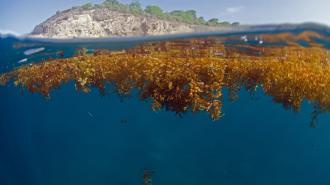This week, Seaweed Generation is embarking on an experiment that could help shape the role of seaweed in slowing or even reversing climate change through carbon dioxide removal (CDR). Armed with a robotic seaweed collection and carbon sequestration device, the startup is headed for a massive patch of invasive seaweed in the Caribbean.
Over the next three months, the company will test its dual-pronged approach of cleaning up the ocean while offsetting human carbon emissions by targeting a type of seaweed called sargassum.
Two birds, one stone: A number of startups are exploring seaweed-based carbon sequestration. Some are growing kelp forests to harvest, while others have produced floating “farms” with the same goal: Collecting carbon in plant matter and then sinking it to the bottom of the ocean to bury its carbon.
But because Seaweed Generation is targeting the Great Sargassum Belt — a sprawling patch of free-growing seaweed nearly the length of Brazil — there’s no need to grow anything new. The seaweed is already there, waiting to be collected and dragged to the depths.
The sargassum patch has been on scientists’ radars for over a decade. Stretching across the central Atlantic, the explosive growth of this problematic plant is a huge nuisance and growing threat to coastal communities and native species.
Many uses for the plant matter have been proposed and tested, but unlike some other types of seaweed, sargassum doesn’t make for a suitable natural fertilizer or animal feed without significant processing.
Worse, sargassum absorbs arsenic and cadmium from the ocean and then transfers those toxic heavy metals to plants grown in sargassum-enriched soil. Even dragging it onto the shore to kill it can contaminate the ground, and the decomposing plant produces hydrogen sulfide, which is an air pollutant that can cause respiratory failure in humans.
Both toxic and invasive, sargassum is the perfect candidate for carbon sequestration, and Seaweed Generation is eager to test the protocol it’s devised over the past two years.
Crushing depth: Sargassum floats thanks to air bladders called pneumatocysts. They look like berries from the outside, but inside they’re hollow, holding small amounts of air that keep the entire plant afloat.
Dragging a chunk of the weed 10, 20, or even 50 meters beneath the surface would only temporarily hinder it, and it would quickly resurface. However, dragging it to a depth of 200 meters causes the air bladders to rupture, eliminating the plant’s buoyancy and allowing it to sink to the bottom.
Seaweed Generation’s robotic prototype, which CEO Patricia Estridge describes as “Pac-Man meets a Roomba,” travels along the surface, gobbling up the sargassum until it’s full. The robot, called the AlgaRay, then dives 200 meters until the seaweed’s air pockets collapse. Then the robot’s payload is released, sinking to the ocean floor and taking its carbon with it.
It’s this system that the company will be testing over the next three months.
“In the last 12 months we built the AlgaRay and we’ve tested (and destroyed) many prototypes,” Estridge says. “We’ve done each piece of the process with separate smaller inventions, so we know that each part of it works independently.”
Now, all of the pieces have come together into a robot that will soon be put to the test in real-world conditions. Part of that testing includes ensuring that the sequestered seaweed ends up where it should.
“[We’ll be] monitoring the seabed, tracing where the seaweed gets dropped off so we can model the sinking rate and drift rate, so we know more about exactly where we need to drop it,” Estridge explains.
The final version of the AlgaRay will borrow from nature for its design, looking like a sleek, robotic manta ray in concept images from the company. The prototype, however, emphasizes function over form.
“It has a solar-powered catamaran on the surface, and then [the robot] is remotely driven. It has the automation to go from point A to point B, but it doesn’t know that it’s in a sargassum patch or know to sink it. There’s a human operator to do that part for now,” Estridge says.
The ultimate vision, which will resemble the manta ray concept, will be a self-contained unit. Solar cells will cover the top of the robot and the sargassum collection, diving, and resurfacing will be entirely automated.
A marathon, not a sprint: Tackling the colossal weed patch in the Atlantic will take a long time, and even in the most optimistic timeline, it would take years or even decades of work to address.
Shrinking the mass and locking the carbon away should be a huge net positive, but understanding how the seabed and ocean ecosystems react to the sargassum removal is top of mind for Seaweed Generation.
“We have work to do on the deep ocean, making sure we understand what the microbial responses are and figuring out those parameters,” Estridge notes. “Not only is the sargassum an opportunity to learn about CDR with seaweed, it’s also a really efficient way of discovering those barriers.”
In the future, Estridge says Seaweed Generation plans to explore how non-invasive seaweed cultivation could further boost the company’s carbon removal abilities. An all-new robot, called the AlgaVator, would help to automate that process and is on the company’s roadmap.
But first thing’s first: The AlgaRay is headed for the Caribbean, and it’s time to sink some sargassum.
We’d love to hear from you! If you have a comment about this article or if you have a tip for a future Freethink story, please email us at tips@freethink.com.
